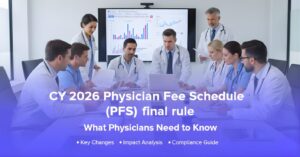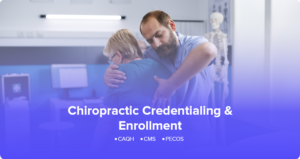By 2027, the Centers for Medicare & Medicaid Services (CMS) will launch the Ambulatory Specialty Model (ASM), a major step in shifting specialty care from fee-for-service to value-based reimbursement.
Designed for outpatient specialists, ASM ties payments to outcomes and cost efficiency rather than procedure volume. For cardiology, orthopedics, and pain management practices, this model will redefine billing, compliance, and financial strategy, turning data accuracy and performance reporting into the new currency of reimbursement.
What Is the Ambulatory Specialty Model (ASM)?
The Ambulatory Specialty Model is a mandatory value-based care program designed for outpatient specialists managing high-cost, high-volume conditions like low back pain and heart failure.
Unlike FFS, where payment is tied to procedures, ASM reimburses based on measurable performance metrics, clinical coordination, and patient outcomes.
In short, ASM encourages specialists to:
- Deliver coordinated, cost-effective, and evidence-based care.
- Focus on preventive management, not episodic treatment.
- Adopt interoperable systems that enable seamless data sharing.
- Achieve measurable, reportable improvements in patient outcomes.
Why CMS Is Introducing ASM
For years, programs like MIPS Value Pathways (MVP) and ACO REACH advanced value-based care for primary care providers, but specialty practices remained fragmented and mostly FFS-driven.
CMS created ASM to bridge that gap and bring accountability, coordination, and efficiency to outpatient specialty care.
Key CMS goals include:
- Efficiency: Reduce redundant imaging, procedures, and testing
- Accountability: Tie payment to quality performance and outcomes
- Transparency: Standardize reporting for cost and care data
- Integration: Encourage collaboration between specialists and PCPs
Read: Latest MIPS Changes & Updates for 2025
Eligibility and Participation Criteria
Initially, CMS will target two key condition-based cohorts:
- Low Back Pain Management (orthopedics, pain medicine, physical medicine & rehabilitation)
- Heart Failure Management (cardiology, internal medicine, hospitalists)
Over time, CMS plans to expand ASM participation to include additional ambulatory specialties such as gastroenterology, neurology, and pulmonology, particularly those with high outpatient volumes and predictable care patterns.
To participate, specialists must:
- Operate in Medicare Part B ambulatory settings.
- Use Certified Electronic Health Record Technology (CEHRT)
- Meet interoperability and reporting standards.
- Demonstrate data submission capability for outcome and cost metrics.
Read: Medicare Finalizes Controversial Cut to Specialty Care for 2026
ASM vs. MIPS Value Pathways: Key Differences
While ASM may resemble the MIPS Value Pathways (MVP) program, there are key distinctions that every specialist should understand.
| Feature | ASM (Ambulatory Specialty Model) | MIPS Value Pathways (MVP) |
| Purpose | Specialty-specific value-based payment model | Broad performance measurement framework |
| Scope | Targets outpatient specialists (e.g., cardiology, ortho) | Includes both primary and specialty care |
| Payment Structure | Bundled or shared-savings tied to outcomes | Performance-based adjustments to FFS payments |
| Participation | Mandatory (for selected conditions) | Voluntary |
| Data Integration | Requires CEHRT and interoperability | Encourages but does not mandate |
Understanding this difference is crucial ASM will not be optional once implemented. Specialists who prepare early will be better positioned to thrive under new reimbursement rules.
How ASM Will Reshape Specialty Billing and Reimbursement
The introduction of ASM means billing teams and RCM partners must evolve beyond claim submission and payment posting.
Here’s what will change most:
1. Documentation Will Drive Revenue
Detailed, compliant documentation will be essential for proving the clinical reasoning behind procedures, medication usage, and outcomes.
Incomplete documentation could trigger claim delays or reduced payments under performance scoring.
2. Coding Accuracy Becomes Mission-Critical
CPT, ICD-10, and HCPCS codes must align with ASM’s defined care pathways.
Errors in coding, especially when documenting comorbidities or procedural time, may distort performance data and result in revenue penalties.
3. Reimbursement Will Depend on Quality Metrics
CMS will give financial incentives to the providers who will be able to show efficiency in costs, observance of the best evidence-based protocols, and improvement in measurable outcomes (e.g., readmissions reduction, imaging utilization decline).
4. Interoperability Will Be Non-Negotiable
ASM insists on fluent data transfer between the providers and the insurance companies. Those specialists who are working with non-integrated EHR systems or RCM platforms may end up being the last ones to comply with the reporting requirements.
5. Payer Audits Will Intensify
With the shift of payments to value-based outcomes, CMS and commercial payers will be conducting audits more often to ensure that the reporting is accurate and compliance is maintained.
How ASM Impacts Key Specialties
Cardiology
Cardiologists treating chronic heart failure patients will face increased reporting requirements for medication management, care coordination, and readmission reduction.
ASM will measure quality metrics such as 30-day readmission rates and EF improvement documentation, directly influencing reimbursements.
Orthopedics & Pain Medicine
For low back pain, CMS aims to reduce unnecessary surgeries and imaging.
Practices will be rewarded for using conservative treatment pathways and demonstrating measurable pain/function improvements over time.
Spine & Physical Medicine Specialists
Documentation of pain management plans, therapy outcomes, and patient education will play a crucial role in earning full reimbursement under ASM.
Financial Implications: Risks and Opportunities
While ASM presents potential revenue risks, particularly for practices that rely heavily on procedure-based payments, it also opens new opportunities:
| Risk | Opportunity |
| Payment reductions for high-cost care episodes | Shared savings for cost-effective outcomes |
| Increased documentation workload | Enhanced RCM automation and interoperability |
| Payer audits and compliance pressure | Greater transparency and predictable payments |
| Short-term disruption during transition | Long-term financial stability and improved patient satisfaction |
Specialists who adapt early by investing in data analytics, billing automation, and compliance tools will benefit most from ASM’s incentive-driven reimbursement model.
How CloudRCM Solutions Supports Specialists in the ASM Era
At CloudRCM Solutions, we understand that transitioning to value-based care takes more than coding updates, it requires a complete RCM transformation.
Our team helps specialists prepare for ASM by building compliant, data-driven billing systems that align with CMS requirements.
We focus on:
- Readiness Assessments: Evaluate documentation, coding, and interoperability gaps.
- Coding Optimization: Align CPT and ICD-10 codes with ASM-specific pathways.
- Data Integration: Set up CEHRT-compliant EHR and billing connections.
- Performance Dashboards: Track real-time outcomes, costs, and compliance metrics.
- Denial Prevention: Identify payer-specific risks and improve clean claim rates.
With CloudRCM as your partner, you can stay compliant, prevent penalties, and protect your specialty revenue as ASM goes live.
Preparing for ASM 2027: A Readiness Checklist
- Review your EHR system for CEHRT and interoperability compliance
- Update documentation workflows to reflect outcome-based care
- Train providers and billing staff on ASM-specific reporting requirements
- Benchmark your performance metrics against CMS standards
- Conduct a financial risk analysis for value-based payment models
- Collaborate with your RCM partner to align your billing strategy with ASM goals
Conclusion: The Future of Specialty Billing Is Value-Based
The CMS Ambulatory Specialty Model is a major turning point for outpatient specialists, the new paradigm being based on value, outcomes, and coordination instead of volume at all.
The specialists in cardiology, orthopedic surgery and pain management are going to secure their position in the market and continue to be compliant with regulations only if they prepare very early.
With in-depth knowledge of Medi-Cal, Medicare, and commercial payer requirements, CloudRCM Solutions makes it easy for specialty practices to shift into value-based billing models like ASM, thus turning compliance issues into advantages for their growth.
FAQ’s
What is the CMS Ambulatory Specialty Model (ASM)?
The ASM represents a Medicare value-based care model for outpatient specialists, which is a new one. It ties reimbursement to quality and outcomes rather than to procedure volume.
Who will be affected first by ASM?
The first to be included will be among the specialists treating low back pain (orthopedics, pain medicine) and heart failure (cardiology), and later on more specialties will be added to the list.
Is participation in ASM mandatory?
Yes, CMS plans to make ASM a mandatory model starting with selected conditions in 2027.
How does ASM differ from MIPS Value Pathways?
While MIPS is voluntary and focuses on general performance reporting, ASM directly ties payments to outcomes and is specialty-specific.
How can RCM partners help with ASM compliance?
Experienced billing partners like CloudRCM provide coding alignment, EHR integration, and compliance analytics to help practices thrive under ASM.

 Medical Billing
Medical Billing Medical Coding
Medical Coding Medical Audit
Medical Audit Provider Credentialing
Provider Credentialing Denial Management
Denial Management A/R Follow-up
A/R Follow-up Private Practice
Private Practice Patient Help Desk
Patient Help Desk Customized Reporting
Customized Reporting Out-of-Network Billing
Out-of-Network Billing Internal Medicine
Internal Medicine Pediatrics
Pediatrics Radiology
Radiology Surgery
Surgery Emergency Medicine
Emergency Medicine Anesthesiology
Anesthesiology Cardiology
Cardiology Orthopedic
Orthopedic Psychiatry
Psychiatry Dentistry
Dentistry OB-GYN
OB-GYN Family Medicine
Family Medicine


